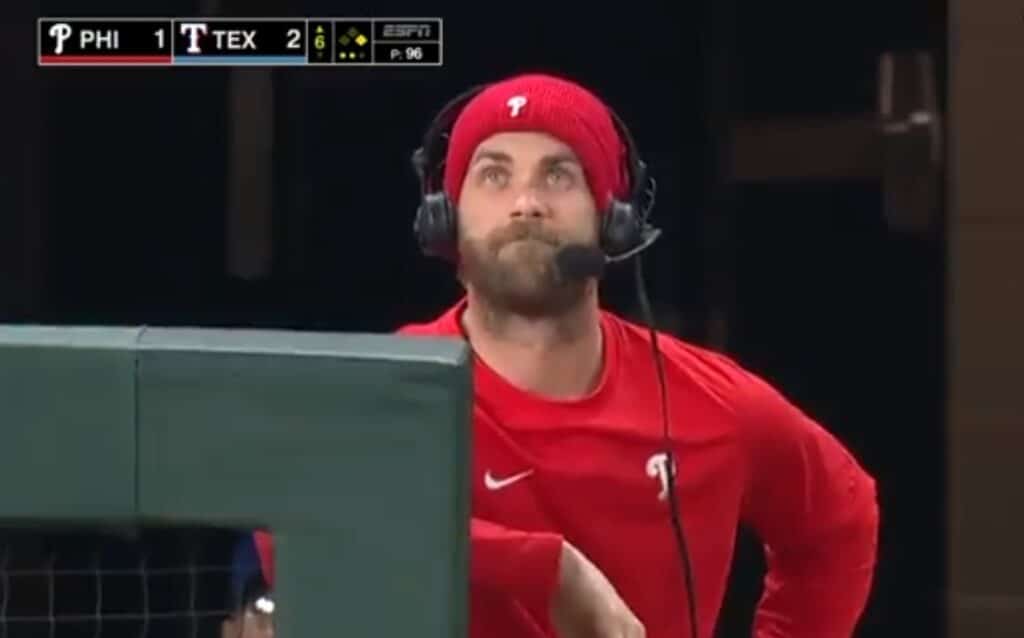Ad Disclosure
Bryce Harper Ranked 40th in ESPN List of Top Postseason Players

ESPN’s David Schoenfield did a ranking of the top 40 players in the 2023 MLB playoffs. The list contains a grand total of two Phillies – Zack Wheeler at 34 and Bryce Harper at 40:
40. Bryce Harper, 1B, Phillies
Strength: The final numbers turned out fine — .293/.401/.499, 21 home runs — but it took 16 home runs the final two months to get there after failing to hit for much power when he returned quickly from Tommy John surgery. His second-half numbers are a better representation of what to look for in October: .296/.413/.583. More than anything, however, it’s his ability to rise to the occasion. Who can forget the home run off Robert Suarez to clinch last year’s NLCS?
Weakness: This is kind of odd, given Harper has one of the highest walk rates in the majors and an average strikeout rate, but his whiff rate is way down in the 11th percentile. So he swings and misses a lot. And his chase rate is also way down in the 21st percentile. Let’s just say he doesn’t get cheated on his swings.
Normally when you see something fugazi like this, the justification is some dumbo analytic model that just barfs out numbers without taking any kind of intangibles into context.
Case in the point, the description at the top of the page:
Here’s what I did. I took each player’s regular-season WAR (the average between Baseball-Reference and FanGraphs), adjusted it for playing time (so a player like Harper, who missed time in the regular season but will play every day in the postseason, isn’t penalized) and factored in how deep a playoff run is expected from his team (using my colleague Brad Doolittle’s odds, based on 10,000 postseason simulations).
I made a couple of tweaks to a player’s WAR. First, I weighed a player’s offensive contribution a little more. Not because defense isn’t still important in the postseason — it is! — but because offense is so hard to generate. The overall batting average last postseason was .211 and the OPS a meager .649. In 2021, teams hit .244 with a .709 OPS. So those players who do hit can often have a bigger influence on the playoff outcomes. Likewise, all the extra off days mean a team’s best starters and relievers pitch more often than in the regular season, so I gave them a value boost, as well. Last season, for example, Framber Valdez‘s percentage of innings for the Astros increased from 13.9% in the regular season to 19.8%. Zack Wheeler went from 10.7% to 23.8%. In 2021, Max Fried went from 11.8% to 19.8%. Relievers might come close to doubling their percentage.
All of that means this isn’t a ranking of the 40 best players in the postseason! Great players we think won’t play long will be lower on this list. Instead, you get this: our list of the 40 players ready to make the biggest impact this postseason.
Uhh.. okay. That methodology is still incredibly dumb. The name of the article is “October Impact Rankings: Top 40 players in 2023 MLB playoffs.” The player who is last on the list is the 2021 MVP, who last season had 22 postseason hits, 6 postseason home runs, 13 postseason RBI, a postseason .349/.414/.716 slash line, and a postseason 1.160 OPS.
If your list has Harper at 40, your list sucks.
Kevin has been writing about Philadelphia sports since 2009. He spent seven years in the CBS 3 sports department and started with the Union during the team's 2010 inaugural season. He went to the academic powerhouses of Boyertown High School and West Virginia University. email - k.kinkead@sportradar.com